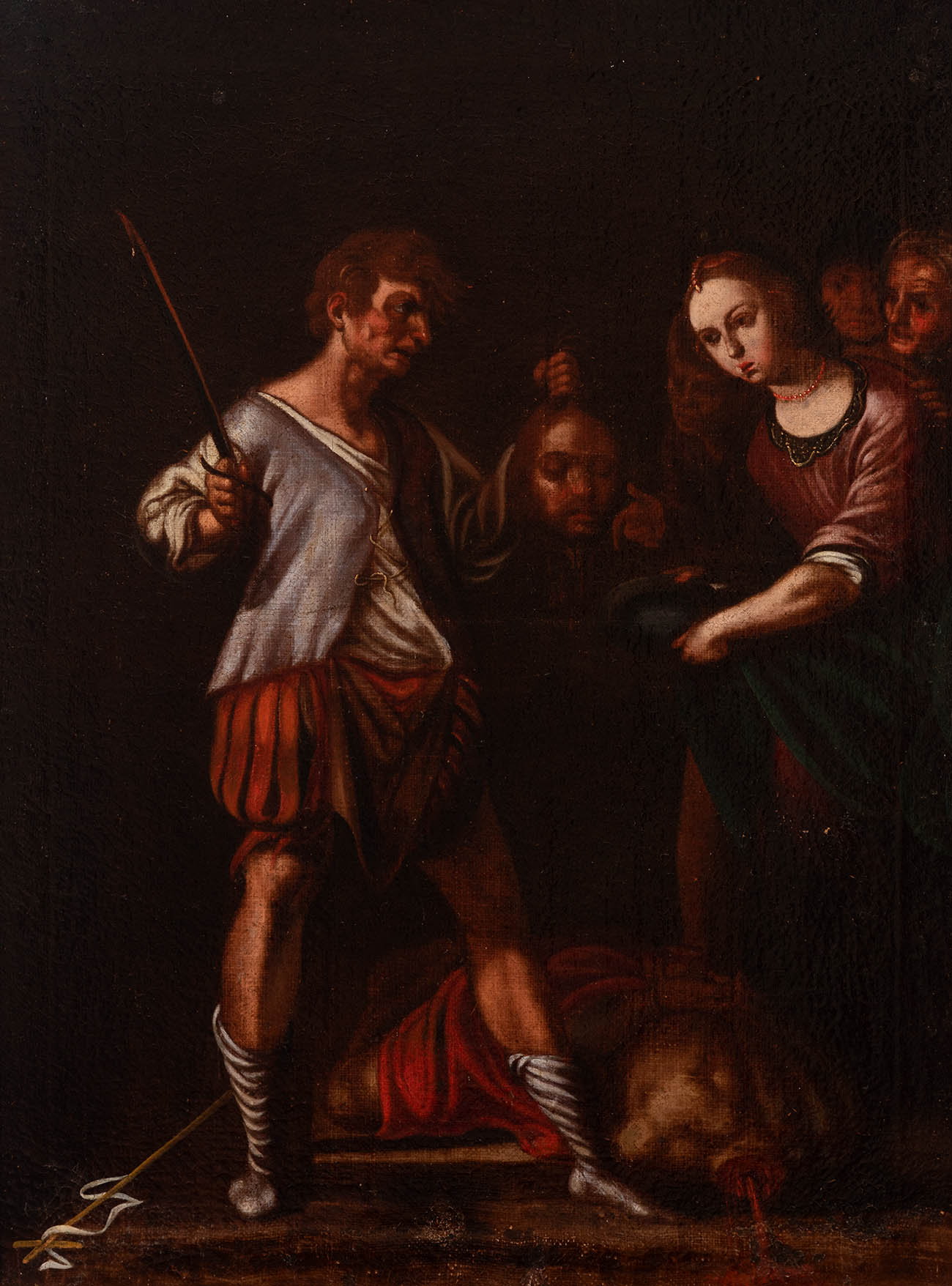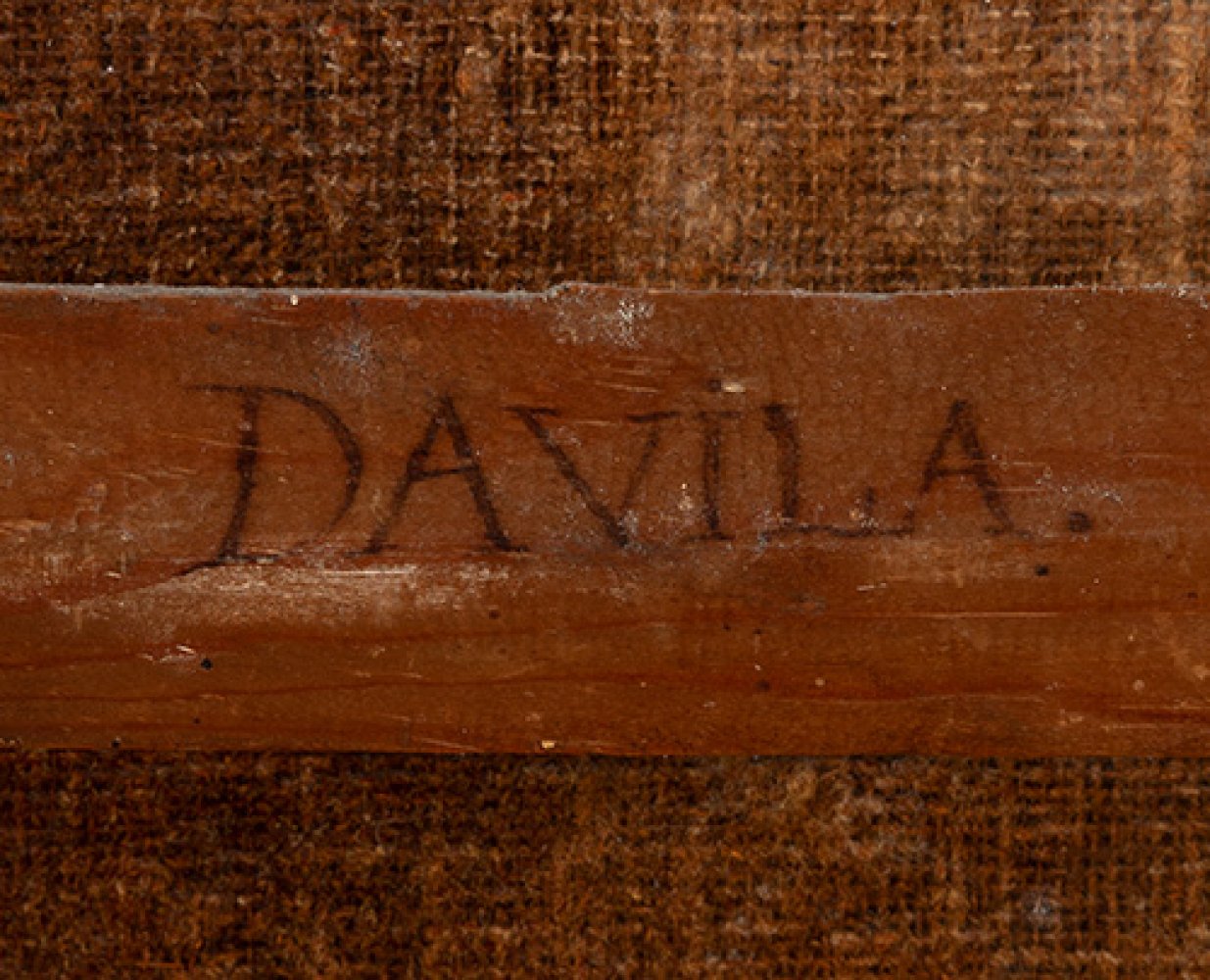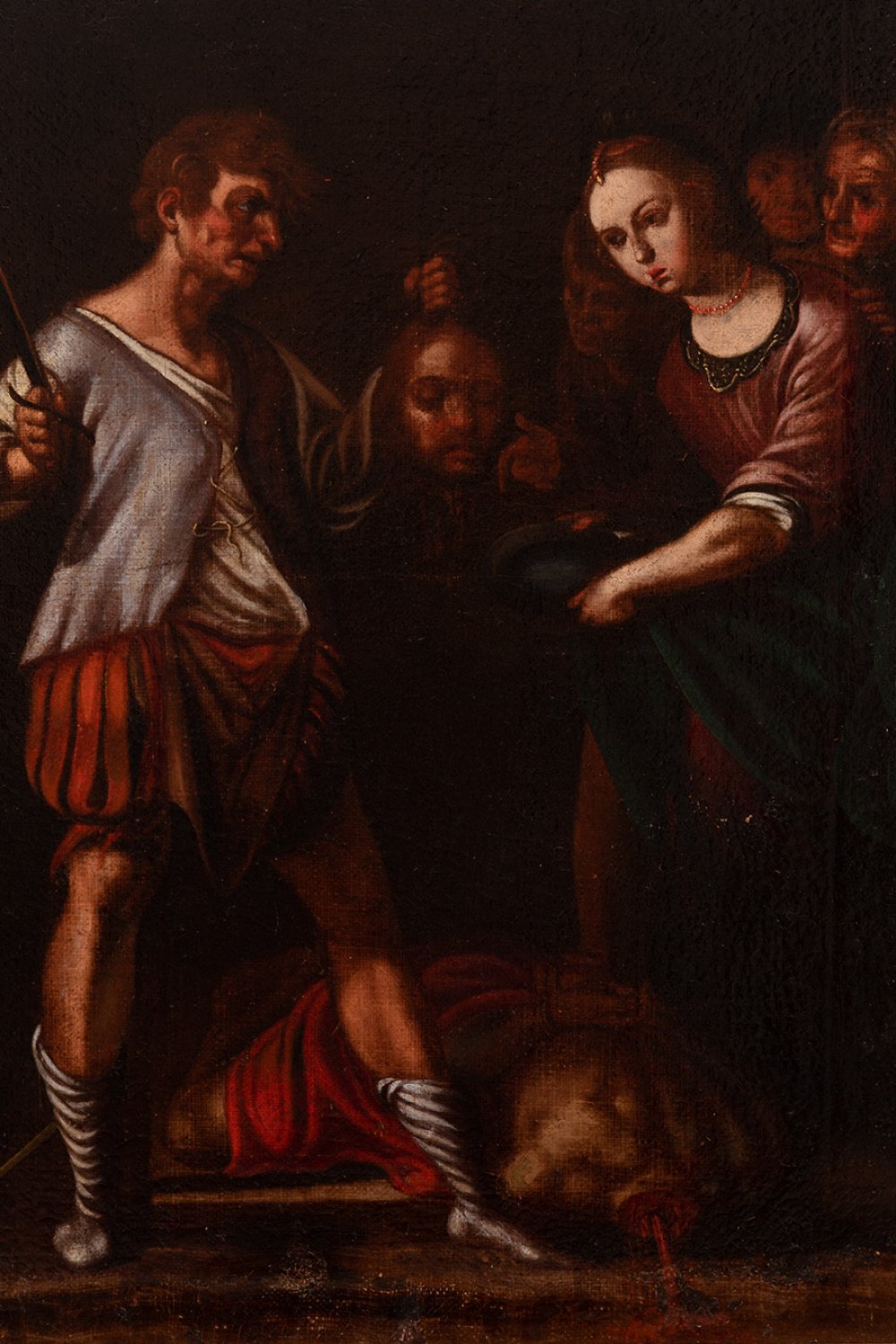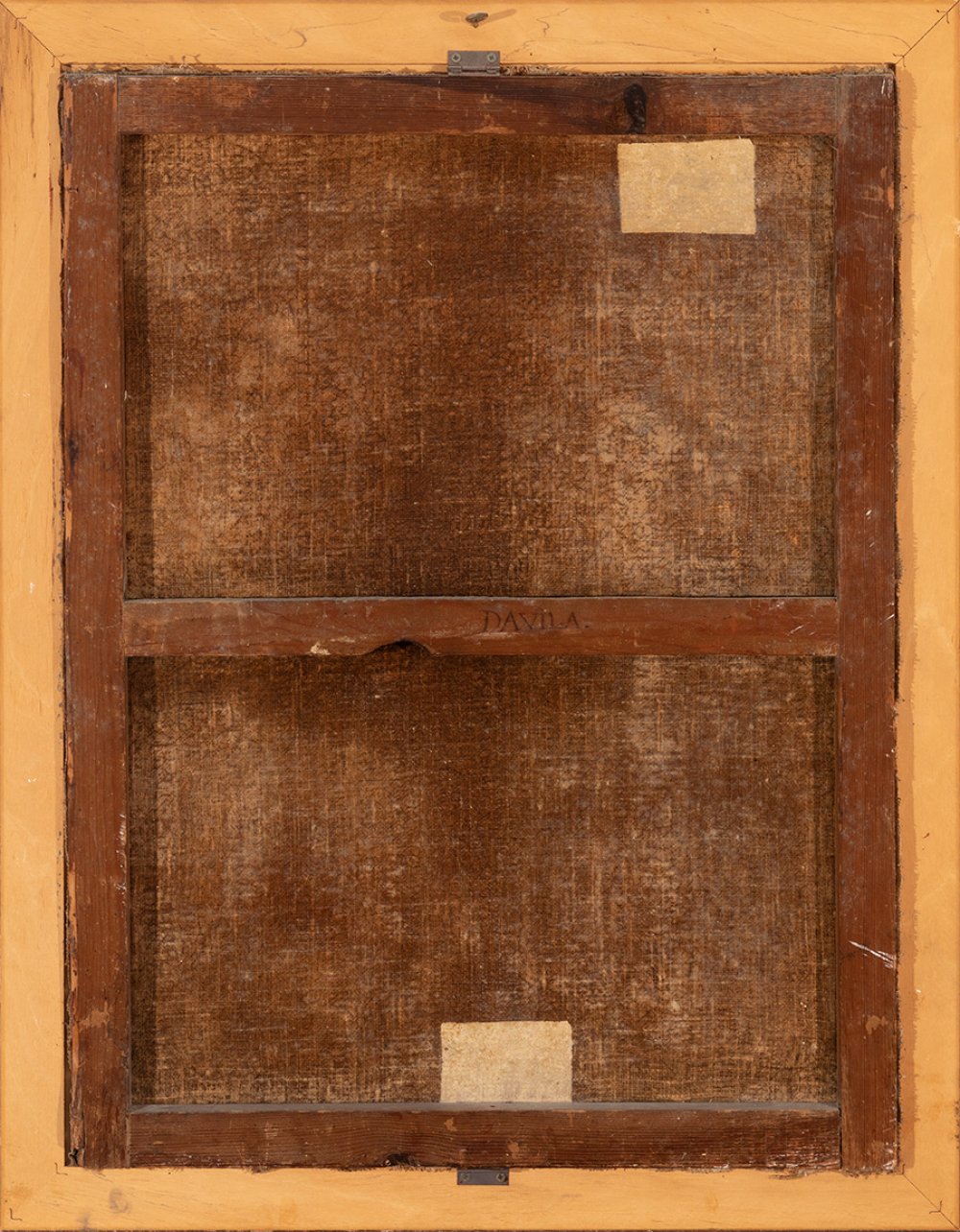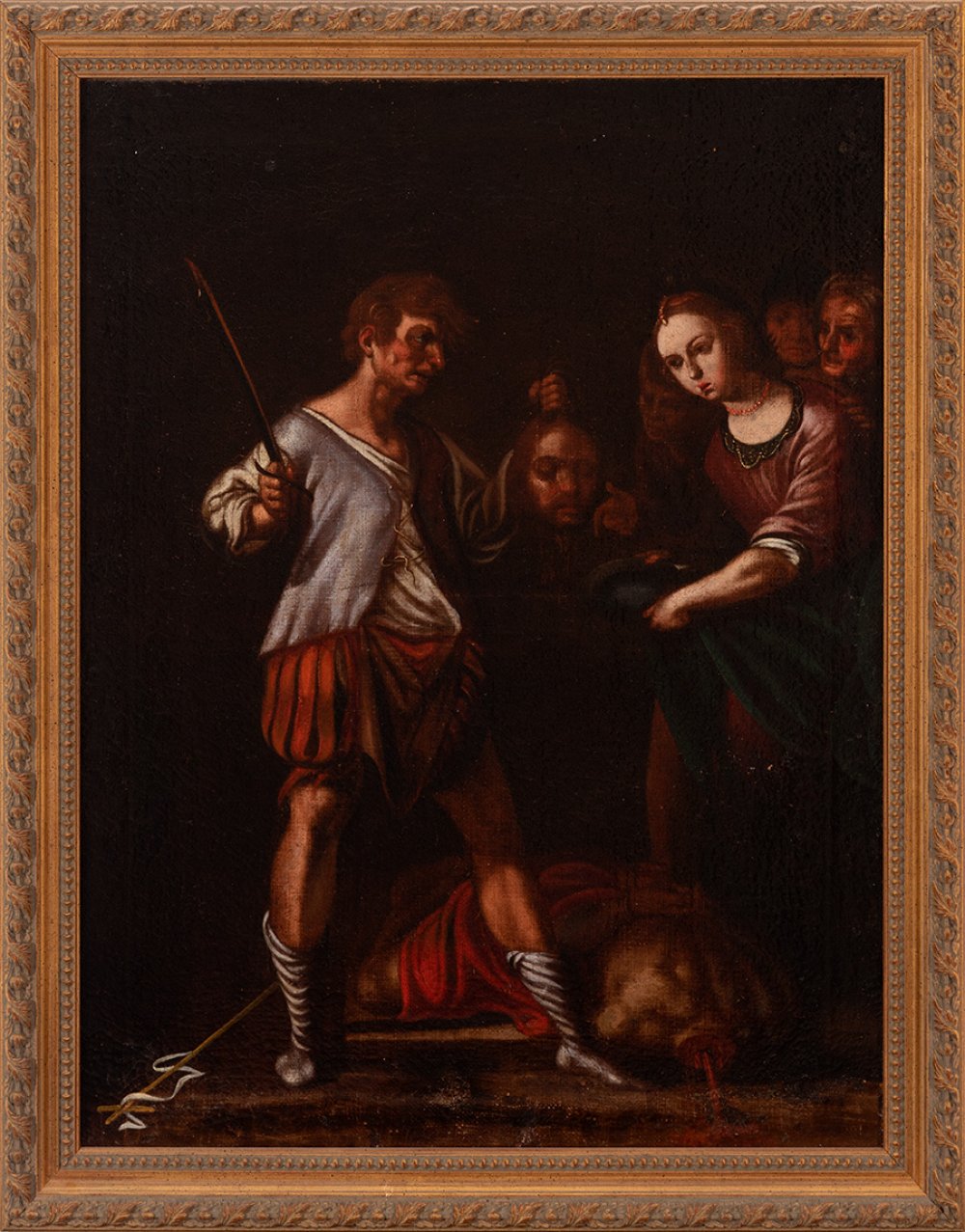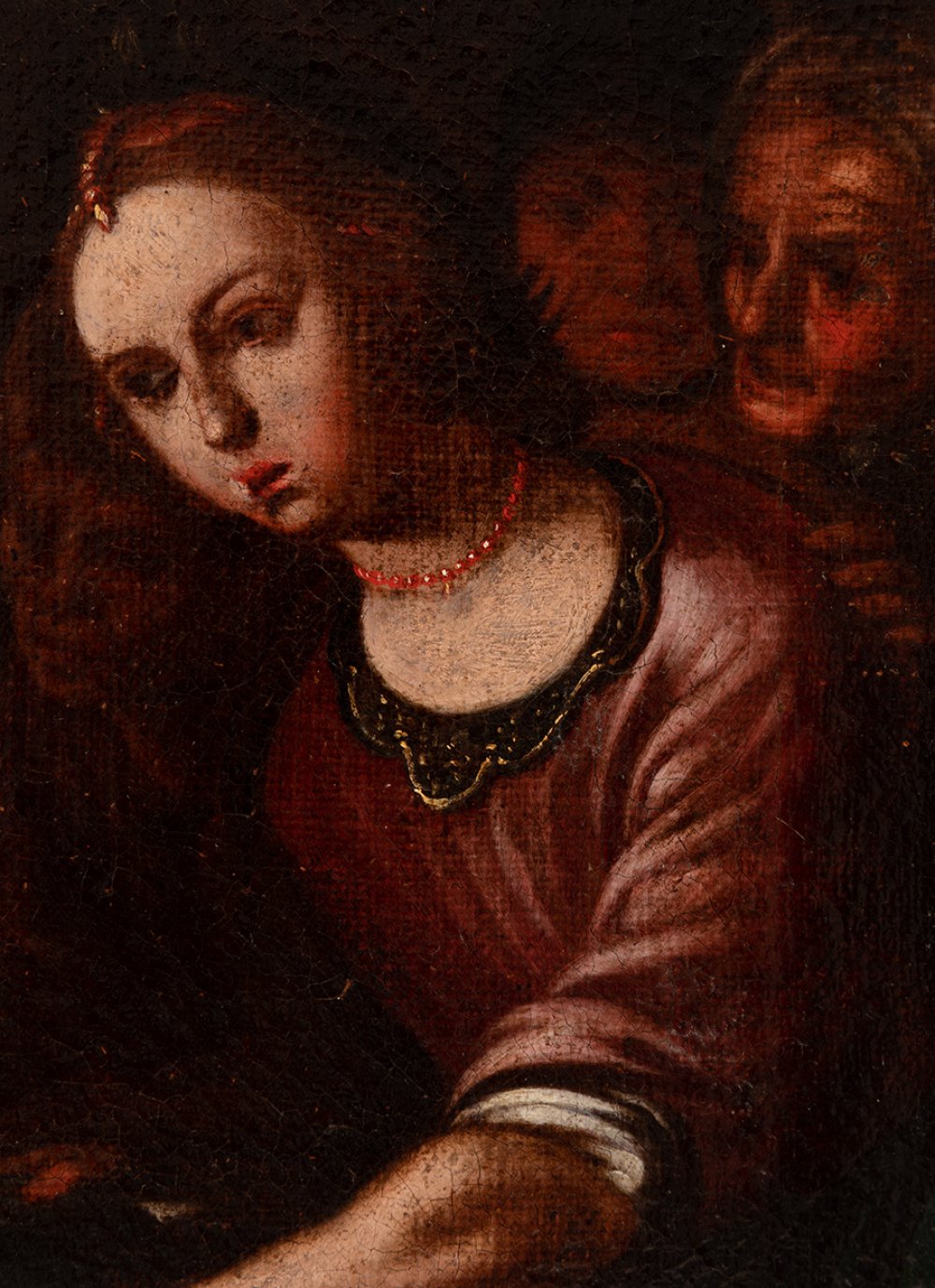57
Workshop of ANTONIO DEL CASTILLO Y SAAVEDRA (Cordoba, 1616 - 1668)."Salome receiving the head of
"Salome receiving the head of Saint John the Baptist".
Oil on canvas. Preserves original canvas.
Presents inscription on the back.
Measurements: 66 x 50 cm; 75 x 59 cm (frame).
Herodias, wife of Herod Philip, married in a scandalous way with his half-brother, Herod Antipas, which provoked a war, since Herod Antipas had repudiated his previous wife, daughter of the Nabataean monarch. The attitude of the new marriage was highly criticised by the people, as it was considered sinful, and one of those who denounced it the most was John the Baptist, for which he was arrested, although Herod did not dare to execute him for fear of the people's wrath. According to tradition, Salome, a woman of great beauty, danced for her stepfather, and he enthusiastically offered to grant her the prize she desired. The young woman then asked, following her mother's instructions, for the Baptist's head, which was given to her "on a silver platter". This work stands out for its narrative unity, as we can appreciate the precise moment when Salome receives the head of the saint, who has just been beheaded. The dramatic way in which the saint's body is presented to the viewer is particularly noteworthy, and is heightened by the way in which Salome steps on the dead body of Saint John.
Due to the technical characteristics of the work, this painting can be classified as one of Antonio del Castillo's artistic circle. Considered the father of the Cordovan school, known for his work as a painter, he was also a polychromator and designer of architectural, decorative and goldsmith's projects. He was the son of Agustín del Castillo, a little-known painter from Llerena (Extremadura) whom Palomino describes as an "excellent painter". It is also thought that he may have trained as a polychromator in Calderón's workshop. However, he was orphaned when he was only ten years old in 1626 and went on to train in the workshop of another painter of whom we have no record, Ignacio Aedo Calderón. Although there is no real evidence of this, it is thought that he may have arrived in Seville, where, according to Palomino, he entered Zurbarán's workshop. This has been corroborated by the stylistic influence of the Extremaduran master that historians have seen in Castillo's work. However, in 1635 he returned to his native Cordoba, where he married and settled permanently, eventually becoming the city's most important artist without question. His fame and quality earned him important commissions, including religious altarpieces, portraits and medium-format series. He was also the teacher of outstanding Cordoban painters of the following generation, such as Juan de Alfaro and Gámez. With regard to his language, Antonio del Castillo did not develop an obvious evolution in his work, although towards the end of his life a more softened language can be discerned, and he remained on the fringes of the baroque innovations of other contemporary painters. However, like the rest of his contemporaries, he was seduced by the novelty of Murillo's work, and in his last years he introduced the Venetian chromatic softness of the Sevillian master. Today, examples can be found in the Prado Museum, the Hermitage in St Petersburg, the J. Paul Getty in Los Angeles, the Louvre, the Metropolitan in New York, etc.
"Salome receiving the head of Saint John the Baptist".
Oil on canvas. Preserves original canvas.
Presents inscription on the back.
Measurements: 66 x 50 cm; 75 x 59 cm (frame).
Herodias, wife of Herod Philip, married in a scandalous way with his half-brother, Herod Antipas, which provoked a war, since Herod Antipas had repudiated his previous wife, daughter of the Nabataean monarch. The attitude of the new marriage was highly criticised by the people, as it was considered sinful, and one of those who denounced it the most was John the Baptist, for which he was arrested, although Herod did not dare to execute him for fear of the people's wrath. According to tradition, Salome, a woman of great beauty, danced for her stepfather, and he enthusiastically offered to grant her the prize she desired. The young woman then asked, following her mother's instructions, for the Baptist's head, which was given to her "on a silver platter". This work stands out for its narrative unity, as we can appreciate the precise moment when Salome receives the head of the saint, who has just been beheaded. The dramatic way in which the saint's body is presented to the viewer is particularly noteworthy, and is heightened by the way in which Salome steps on the dead body of Saint John.
Due to the technical characteristics of the work, this painting can be classified as one of Antonio del Castillo's artistic circle. Considered the father of the Cordovan school, known for his work as a painter, he was also a polychromator and designer of architectural, decorative and goldsmith's projects. He was the son of Agustín del Castillo, a little-known painter from Llerena (Extremadura) whom Palomino describes as an "excellent painter". It is also thought that he may have trained as a polychromator in Calderón's workshop. However, he was orphaned when he was only ten years old in 1626 and went on to train in the workshop of another painter of whom we have no record, Ignacio Aedo Calderón. Although there is no real evidence of this, it is thought that he may have arrived in Seville, where, according to Palomino, he entered Zurbarán's workshop. This has been corroborated by the stylistic influence of the Extremaduran master that historians have seen in Castillo's work. However, in 1635 he returned to his native Cordoba, where he married and settled permanently, eventually becoming the city's most important artist without question. His fame and quality earned him important commissions, including religious altarpieces, portraits and medium-format series. He was also the teacher of outstanding Cordoban painters of the following generation, such as Juan de Alfaro and Gámez. With regard to his language, Antonio del Castillo did not develop an obvious evolution in his work, although towards the end of his life a more softened language can be discerned, and he remained on the fringes of the baroque innovations of other contemporary painters. However, like the rest of his contemporaries, he was seduced by the novelty of Murillo's work, and in his last years he introduced the Venetian chromatic softness of the Sevillian master. Today, examples can be found in the Prado Museum, the Hermitage in St Petersburg, the J. Paul Getty in Los Angeles, the Louvre, the Metropolitan in New York, etc.
9th March - Old Masters
Sale Date(s)
Venue Address
General delivery information available from the auctioneer
Setdart offers Worldwide shipping
PICK UP IN ROOM: You can come and pick up your lots in our offices (Barcelona, Madrid or Valencia). At the moment of the withdrawal, you will be able to accept the current conditions of the lot by means of a document that you will sign.
YOU CAN SEND ANOTHER PERSON TO PICK UP: This person must present a signed authorization that you can find in our web page by accessing from BUY AT SETDART- LOGISTICS-DOWNLOAD AUTHORIZATION DOCUMENT. You can also send an e-mail with the requested data in AUTHORIZATION DOCUMENT to admin@setdart.com
Important Information
22% buyer´s premium
18% buyer´s premium at www.setdart.com
Terms & Conditions
The maximum period to pay the lots is 7 working days. You can pay either via bank transfer or with credit card through our platform www.setdart.com (we only accept VISA or Mastercard).
BUYER´S PREMIUM: 22% Hammer price + 21% VAT from the buyer´s premium
If your piece has more than 100 years, our Ministry of Culture requires an export certificate in order for the piece to leave the country. Note that if the piece goes inside the EU, there is no cost for the export certificate. If the piece goes outside the EU, there is a cost for the export certificate. You can find more information in our Ministry of Culture website: https://www.culturaydeporte.gob.es/en/cultura/patrimonio/exportacionimportacion/exportacion/tasas.html
INQUIRIES: admin@setdart.com
Setdart guides you through the entire process, from the time of award to the day you receive your lot. Our logistics team will be happy to manage your transport, and will advise you on the best shipping method with professionals from the sector used to handling works of art and jewelry.
WE OFFER WORLDWIDE DOOR TO DOOR SHIPPING
PICK UP IN ROOM: You can come and pick up your lots in our offices. At the moment of the withdrawal, you will be able to accept the current conditions of the lot by means of a document that you will sign.
YOU CAN SEND ANOTHER PERSON TO PICK UP: This person must present a signed authorization that you can find in our web page by accessing from BUY AT SETDART-LOGISTICS-DOWNLOAD AUTHORIZATION DOCUMENT. You can also send an e-mail with the requested data in AUTHORIZATION DOCUMENT to admin@setdart.com
SETDART IS NOT RESPONSIBLE FOR THE STATE OF THE PARTS ONCE THEY LEAVE OUR FACILITIES. MRW SHIPMENTS: Once the payment is made, your lot will be packed for shipment, the logistics department will send you an e-mail notifying you of the day it leaves our warehouse, changes of address cannot be made after receiving this e-mail.
INSURANCE INCIDENTS: Coverage for the value of the auction up to 3000 ? per shipment, if the value of the auction is higher, Setdart will send you a quote including the additional insurance. The insurance company WILL NOT BE RESPONSIBLE FOR THE SHIPMENT THAT EXCEEDS THAT AMOUNT AND IS NOT FULLY INSURED. MRW INCIDENTS: Maximum notification 48 hours after receipt, after which the insurance company WILL NOT BE RESPONSIBLE AND NO CLAIMS WILL BE ACCEPTED.
E-MAIL LOGISTICS: logistica@setdart.com
PICK UP YOUR MESSAGES: You can send your own messaging, prior notice via e-mail that your shipment is ready, please note 3 or 4 days in advance. This type of shipment is packaged so Setdart will provide you with a quote.
EXPENSES FOR STORAGE: We inform you that if the purchased lot is not picked up within a month, you will be charged 30€ per week per lot. Setdart Online S.L., owner of the web site "setdart.com", "setdart.net" and "setdart.org", acts as a company of Spanish nationality inscribed in the Volume 36955, sheet 182, page B-293056 of the Mercantile Registry, with registered office at Calle Aragó















